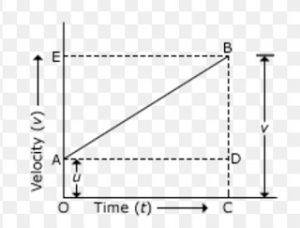Question 1 What is meant by uniform circular motion?
Question 2 A body goes around the sun with constant speed in a circular orbit. Is the motion uniform or accelerated?
Question 3 A satellite goes around the earth in a circular orbit with constant speed. Is the motion uniform or accelerated?
Question 4 Give examples of circular motion?
Question 5 What is a centripetal force. Give example?
Question 6 A cyclist goes around a circular track once every 5 minute. If the radius of the circular track is 110 meters, calculate his speed?
Question 7 Derive first equation of motion by graphical method?
Question 8 Derive second equation of motion by graphical method?
Question 9 Derive third equation of motion by graphical method?
Contents
Uniform Circular Motion
When a body moves in a circle, it is called circular motion.
When a body moves along a circular path, then its direction of motion keeps on changing continuously.
Since the velocity changes (due to continuous change in direction) therefore the motion along a circular path is said to be accelerated. When a body moves in a circular path with uniform speed its motion is called uniform circular motion. The velocity of the body moving in a circle with uniform speed is not uniform because the direction of motion is constantly changing.
For Example:
A stone tied to a thread is rotated in circular path with uniform speed in clockwise direction.
A → Speed is directed towards east.
B → Speed is directed towards south.
Since there is change in direction of speed, the velocity is not uniform.
The motion in a circle with constant speed is an example of accelerated motion.
The force which is needed to make an object travel in circular path is called centripetal force.
For Example :
(1) Movement of artificial satellite around earth .
(2) Motion of moon around earth.
(3) Motion of earth around sun.
(4) Tip of seconds hand of a watch.
(5) Athlete moving on a circular path.
The speed of a body moving along a circular path is given by:
v=2nr/t
Equation of Motion by Graphical Method
(1) Derivation of v=u + at
Initial velocity u at A =OA
Velocity changes from A To B in time t(uniform acceleration a)
Final Velocity v=BC
BC=BD+DC
v=BD+AO
v=BD+u
Slope of velocity time graph is equal to acceleration a.
a= BD
a=BD/AD
a=BD/t
BD = at
v=u+at
(2) Derivation of S = ut +1/2 x at2
The distance travelled by the body is given by area of the space between velocity time graph AB and time axis OC , which is equal to area of figure OABC.
Distance travelled=Area of figure OABC
= Area of rectangle OADC + Area of triangle ABD
=(OA x OC) + 1/2 x AD x BD)
=(u x t) + (1/2 x t x at)
S = ut + 1/2 x at2
(3) Derivation of v2 = u2 + 2as
The distance travelled by body in time t is given by area of figure OABC (which is a trapezium)
s = Area of trapezium OABC
s= Sum of parallel sides x height / 2
s= (OA+OB) x OC / 2
s=(u+v) x t /2
v=u + at
at = v – u
t= v-u /a
s= (u+v) x (v- u)/2a
2as = v2 – u2
v2 = u2 + 2as

Easy
Nice
Good one
Thank you for information
Thank you so much for this.
you saved me in my multiple assessment-1
its very useful to me
Thank you so much ma’am. Very helpful
Thank you mam you made it very easy for me
It’s very helpful for me
Thank you very Easy
It’s very helpful for me
Very useful
It is explained nicely ☺️☺️☺️
Yes you are right
I surfed many sites but it is easiest!!!!!
I love it!!
It’s extremely helpful or good explanation
I was happy because this explanation is very good.
it is more useful
Very Nice Explanation!!
Hope a video comes soon!!!